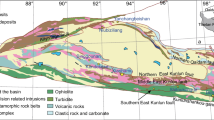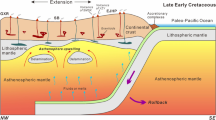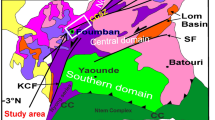Abstract
The origin of low δ18O signals in zircons from the Early Cretaceous A-type granites in eastern China has long been disputed. It is uncertain whether the 18O-depleted features were inherited from high-temperature hydrothermal altered source rock or resulted from water-rock interaction after emplacement. In this paper, zircon oxygen isotopes in the ∼130 Ma Kulongshan A-type granites in the northern North China Craton are analyzed. The zircons could be subdivided into 5 types based on their luminescent intensity and internal structures in CL images. Their δ18O values also vary in different types and show negative correlation with U and Th contents and accompanying cumulative α-decay doses, implying that their δ18O values may have been modified to various degrees by meteoric water-rock interaction after the accumulation of radiation damage. The idea is further confirmed by oxygen isotopic equilibrium calculation between co-existing mineral pairs. It is inferred that only the least-influenced zircons, with slightly elevated δ18O values than normal mantle, have preserved the magmatic oxygen isotopes. In combination with other evidences, it is proposed that the A-type granites are lower-crustal-derived, unnecessarily invoking a high-temperature hydrothermal altered source. The proposition is applicable to many other Cretaceous A-type granites that have similar zircon behaviors.
Similar content being viewed by others
References Cited
Amelin, Y., Lee, D. C., Halliday, A. N., et al., 1999. Nature of the Earth’s Earliest Crust from Hafnium Isotopes in Singledetrital Zircons. Nature, 399: 1497–1503. https://doi.org/10.1038/20426
Bibikova, Y. V., Ustinov, V. I., Gracheva, T. V., et al. 1982. Variations of Isotopic Composition of Oxygen in Accessory Zircons. Doklady Akademii Nauk SSR, 264(3): 698–700
Bindeman, I., 2008. Oxygen Isotopes in Mantle and Crustal Magmas as Revealed by Single Crystal Analysis. Reviews in Mineralogy and Geochemistry, 69(1): 445–478. https://doi.org/10.2138/rmg.2008.69.12
Bindeman, I. N., Schmitt, A. K., Lundstrom, C. C., et al., 2018. Stability of Zircon and Its Isotopic Ratios in High-Temperature Fluids: Long-Term (4 Months) Isotope Exchange Experiment at 850 °C and 50 MPa. Frontiers in Earth Science, 6: 59. https://doi.org/10.3389/feart.2018.00059
Bonin, B., 2007. A-Type Granites and Related Rocks: Evolution of a Concept, Problems and Prospects. Lithos, 97(1/2): 1–29. https://doi.org/10.1016/j.lithos.2006.12.007
Booth, A. L., Kolodny, Y., Chamberlain, C. P., et al., 2005. Oxygen Isotopic Composition and U-Pb Discordance in Zircon. Geochimica et Cosmochimica Acta, 69(20): 4895–4905. https://doi.org/10.1016/j.gca.2005.05.013
Butera, K. M., Williams, I. S., Blevin, P. L., et al., 2001. Zircon U-Pb Dating of Early Palaeozoic Monzonitic Intrusives from the Goonumbla Area, New South Wales. Australian Journal of Earth Sciences, 48(3): 457–464. https://doi.org/10.1046/j.1440-0952.2001.00870.x
Chakoumakos, B. C., Murakami, T., Lumpkin, G. R., et al., 1987. Alpha-Decay—Induced Fracturing in Zircon: The Transition from the Crystalline to the Metamict State. Science, 236(4808): 1556–1559. https://doi.org/10.1126/science.236.4808.1556
Charoy, B., Raimbault, L., 1994. Zr-, Th- and REE-Rich Biotite Differentiates in the A-Type Granite Pluton of Suzhou (Eastern China): The Key Role of Fluorine. Journal of Petrology, 35(4): 919–962. https://doi.org/10.1093/petrology/35A919
Clemens, J. D., Holloway, J. R., White, A. J. R., 1986. Origin of an A-Type Granite: Experimental Constraints. American Mineralogist, 71(3/4): 317–324
Collins, W. J., Beams, S. D., White, A. J. R., et al., 1982. Nature and Origin of A-Type Granites with Particular Reference to Southeastern Australia. Contributions to Mineralogy and Petrology, 80: 189–200. https://doi.org/10.1007/bf00374895
Collins, W. J., Huang, H. Q., Bowden, P., et al., 2019. Repeated S-I-A-Type Granite Trilogy in the Lachlan Orogen and Geochemical Contrasts with A-Type Granites in Nigeria: Implications for Petrogenesis and Tectonic Discrimination. Geological Society, London, Special Publications, 491(1). https://doi.org/10.1144/sp491-2018-159
Deng, X. Q., Peng, T. P., Zhou, Y. Y., et al., 2020. Origin of the Late Paleoproterozoic Low-δ18O A-Type Granites on the Southern Margin of the North China Craton and Their Geodynamic Mechanism. Precambrian Research, 351: 105960. https://doi.org/10.1016/j.precamres.2020.105960
Erdmann, S., Wodicka, N., Jackson, S. E., et al., 2013. Zircon Textures and Composition: Refractory Recorders of Magmatic Volatile Evolution? Contributions to Mineralogy and Petrology, 165: 45–71. https://doi.org/10.1007/s00410-012-0791-z
Ewing, R. C., Meldrum, A., Wang, L. M., et al., 2003. Radiation Effects in Zircon. Reviews in Mineralogy & Geochemistry, 53(1): 387–425. https://doi.org/10.2113/0530387
Fan, W. B., Jiang, N., Xu, X. Y., et al., 2017. Petrogenesis of the Middle Jurassic Appinite And Coeval Granitoids in the Eastern Hebei Area of North China Craton. Lithos, 278–281: 331–346. https://doi.org/10.1016/j.lithos.2017.01.030
Fan, W. B., Jiang, N., Zhai, M. G., et al., 2020. Zircon Constraints on Granite Provenance in the Northern North China Craton. Lithos, 356/357: 105370. https://doi.org/10.1016/j.lithos.2020.105370
Farnan, I., Salje, E. K. H., 2001. The Degree and Nature of Radiation Damage in Zircon Observed by 29Si Nuclear Magnetic Resonance. Journal of Applied Physics, 89(4): 2084–2090. https://doi.org/10.1063/1.1343523
Geisler, T., Schaltegger, U., Tomaschek, F., 2007. Re-equilibration of Zircon in Aqueous Fluids and Melts. Elements, 3(1): 43–50. https://doi.org/10.2113/gselements.3.1.43
Griffin, W. L., Wang, X., Jackson, S. E., et al., 2002. Zircon Chemistry and Magma Mixing: SE China: in-situ Analysis of Hf Isotopes, Tonglu and Pingtan Igneous Complexes. Lithos, 61: 237–269. https://doi.org/10.1016/s0024-4937(02)00082-8
Gao, Y. Y., Li, X. H., Griffin, W. L., et al., 2014. Screening Criteria for Reliable U-Pb Geochronology and Oxygen Isotope Analysis in Uranium-Rich Zircons: A Case Study from the Suzhou A-Type Granites, SE China. Lithos, 192–195: 180–191. https://doi.org/10.1016/j.lithos.2014.02.002
Guo, J. L., Wu, J. H., Niu, Z. L., et al., 2019. Petrogenesis of the Kulongshan Complex Pluton in Northern Hebei: Chronologic and Geochemical Constraints. Acta Metallurgica Sinica, 25(1): 33–50. https://doi.org/10.16108/j.issn1006-7493.2018048 (in Chinese with English Abstract)
Hiess, J., Bennett, V. C., Nutman, A. P., et al., 2011. Archaean Fluid-Assisted Crustal Cannibalism Recorded by Low δ18O and Negative εHf(t) Isotopic Signatures of West Greenland Granite Zircon. Contributions to Mineralogy and Petrology, 161: 1027–1050. https://doi.org/10.1007/s00410-010-0578-z
Holland, H. D., Gottfried, D., 1955. The Effect of Nuclear Radiation on the Structure of Zircon. Acta Crystallographica, 8(6): 291–300
Hoskin, P. W. O., 2005. Trace-Element Composition of Hydrothermal Zircon and the Alteration of Hadean Zircon from the Jack Hills, Australia. Geochimica et Cosmochimica Acta, 69(3): 637–648. https://doi.org/10.1016/j.gca.2004.07.006
Jahn, B. M., Condie, K. C., 1995. Evolution of the Kaapvaal Craton as Viewed from Geochemical and Sm-Nd Isotopic Analyses of Intracratonic Pelites. Geochimica et Cosmochirnica Acta, 59: 2239–2258. https://doi.org/10.1016/0016-7037(95)00103-7
Jahn, B. M., Wu, F. Y., Hong, D., 2000. Important Crustal Growth in the Phanerozoic: Isotopic Evidence of Granitoids from East-Central Asia. Journal of Earth System Science, 109: 5–20. https://doi.org/10.1007/bf02719146
Jahn, B. M., Wu, F. Y., Capdevila, R., et al., 2001. Highly Evolved Juvenile Granites with Tetrad REE Patterns: The Woduhe and Baerzhe Granites from the Great Xing’an Mountains in NE China. Lithos, 59(4): 171–198. https://doi.org/10.1016/s0024-4937(01)00066-4
Javoy, M., Weis, D., 1987. Oxygen Isotopic Composition of Alkaline Anorogenic Granites as a Clue to Their Origin: The Problem of Crustal Oxygen. Earth and Planetary Science Letters, 84(4): 415–422. https://doi.org/10.1016/0012-821x(87)90006-9
Jiang, N., Guo, J. H., Zhai, M. G., et al., 2010. ∼2.7 Ga Continental Crust Growth in the North China craton. Precambrian Research, 179(1–4): 27–49. https://doi.org/10.1016/j.precamres.2010.02.010
Jiang, N., Guo, J. H., Chang, G. H., 2013. Nature and Evolution of the Lower Crust in the Eastern North China Craton: A Review. Earth-Science Reviews, 122: 1–9. https://doi.org/10.1016/j.earscirev.2013.03.006
Li, X. H., Liu, Y., Li, Q. L., et al., 2009. Precise Determination of Phanerozoic Zircon Pb/Pb Age by Multi-Collector SIMS without External Standardization. Geochemistry Geophysical Geosystem, 10: Q04010. https://doi.org/10.1029/2009gc002607
Li, X. H., Long, W. G., Li, Q. L., et al., 2010. Penglai Zircon Megacrysts: A Potential Newworking Reference Material for Micro Beam Determination of Hf-O Isotopes and U-Pb Age. Geostandards and Geoanalytical Research, 34: 117–134. https://doi.org/10.1111/j.1751-908x.2010.00036.x
Li, S. L., Hao, J. J., 2017. REE Ore Mineralization of the Kulongshan A-Type Granites in Eastern Hebei. Huabei Land and Resources, 77: 53–62 (in Chinese)
Liebmann, J., Spencer, C. J., Kirkland, C. L., et al., 2021. Effect of Water on δ18O in Zircon. Chemical Geology, 574: 120243. https://doi.org/10.1016/j.chemgeo.2021.120243
Liu, J. X., 1990. Preparation of Reference Materials for Oxygen Isotope Determination in Silicates. Rock and Mineral Analysis, 9(4): 276–282 (in Chinese with English Abstract)
Liu, Y., Hou, Z. Q., Zhang, R. Q., et al., 2019. Zircon Alteration as a Proxy for Rare Earth Element Mineralization Processes in Carbonatite-Nordmarkite Complexes of the Mianning-Dechang Rare Earth Element Belt, China. Economic Geology, 114(4): 719–744. https://doi.org/10.5382/econgeo.4660
Loiselle, M. C., Wones, D. R., 1979. Characteristics and Origin of Anorogenic Granites. Geological Society of America, Abstracts, 11: 468
Ludwig, K. R., 2012. User’s Manual for Isoplot 3.75: A Geochronological Toolkit for Microsoft Excel. Special Publication No. 5. Berkeley Geochronology Center, Berkeley
McDonough, W. F., Sun, S. S., 1995. The Composition of the Earth. Chemical Geology, 120: 223–253. https://doi.org/10.1016/0009-2541(94)00140-4
Monani, S., Valley, J. W., 2001. Oxygen Isotope Ratios of Zircon: Magma Genesis of Low δ18O Granites from the British Tertiary Igneous Province, Western Scotland. Earth and Planetary Science Letters, 184(2): 377–392. https://doi.org/10.1016/s0012-821x(00)00328-9
Murakami, T., Chakoumakos, B. C., Ewing, R. C., et al., 1991. Alpha-Decay Event Damage in Zircon. American Mineralogist, 76(9/10): 1510–1532
Nasdala, L., Wenzel, M., Vavra, G., et al., 2001. Metamictisation of Natural Zircon: Accumulation versus Thermal Annealing of Radioactivity-Induced Damage. Contributions to Mineralogy and Petrology, 141(2): 125–144. https://doi.org/10.1007/s004100000235
Patiño Douce, A. E., 1997. Generation of Metaluminous A-Type Granites by Low-Pressure Melting of Calc-Alkaline Granitoids. Geology, 25(8): 743–746. https://doi.org/10.1130/0091-7613(1997)025<0743:gomatg>2.3.co;2
Peck, W. H., Valley, J. W., Graham, C. M., 2003. Slow Oxygen Diffusion Rates in Igneous Zircons from Metamorphic Rocks. American Mineralogist, 88(7): 1003–1014. https://doi.org/10.2138/am-2003-0708
Pidgeon, R. T., Nemchin, A. A., Cliff, J., 2013. Interaction of Weathering Solutions with Oxygen and U-Pb Isotopic Systems of Radiation-Damaged Zircon from an Archean Granite, Darling Range Batholith, Western Australia. Contributions to Mineralogy and Petrology, 166(2): 511–523. https://doi.org/10.1007/s00410-013-0888-z
Qiu, K. F., Yu, H. C., Wu, M. Q., et al., 2019. Discrete Zr and REE Mineralization of the Baerzhe Rare-Metal Deposit, China. American Mineralogist, 104(10): 1487–1502. https://doi.org/10.2138/am-2019-6890
Silver, L. T., Deutsch, S., 1963. Uranium-Lead Isotopic Variations in Zircons: A Case Study. The Journal of Geology, 71(6): 721–758
Steiger, R. H., Jager, E., 1977. Subcommission on Geochronology: Convention on the Use of Decay Constants in Geo- and Cosmochronology. Earth and Planetary Science Letters, 36: 359–362. https://doi.org/10.1016/0012-821x(77)90060-7
Sun, J. F., Yang, J. H., 2009. Early Cretaceous A-Type Granites in the Eastern North China Block with Relation to Destruction of the Craton. Earth Science, 34: 137–147 (in Chinese with English Abstract)
Sun, J. F., 2011. Petrogenesis of Early Cretaceous A-Type Granites in the Northern Liaodong Peninsula: Implications for Decratonization of the North China Craton: [Dissertation]. University of Chinese Academy of Sciences, Beijing. 103–105 (in Chinese)
Tang, J., Xu, W. L., Wang, F., et al., 2018. Subduction History of the Paleo-Pacific Slab beneath Eurasian Continent: Mesozoic-Paleogene Magmatic Records in Northeast Asia. Science China Earth Sciences, 61: 527–559. https://doi.org/10.1007/s11430-017-9174-1
Taylor, H. P., 1988. Oxygen, Hydrogen and Stronium Isotope Constaints on the Origin of Granite. Transactions of the Royal Society of Edinburg: Earth Science, 79: 317–338
Taylor, S. R., McLennan, S. M., 1985. The Continental Crust: Its Composition and Evolution. Blackwell Scientific Publications, Oxford
Trail, D., Bindeman, I. N., Watson, E. B., et al., 2009. Experimental Calibration of Oxygen Isotope Fractionation between Quartz and Zircon. Geochimica et Cosmochimica Acta, 73(23): 7110–7126. https://doi.org/10.1016/j.gca.2009.08.024
Troch, J., Ellis, B. S., Schmitt, A. K., et al., 2018. The Dark Side of Zircon: Textural, Age, Oxygen Isotopic and Trace Element Evidence of Fluid Saturation in the Subvolcanic Reservoir of the Island Park Mount Jackson Rhyolite, Yellowstone (USA). Contributions to Mineralogy and Petrology, 173(7): 54. https://doi.org/10.1007/s00410-018-1481-2
Valley, J. W., Kinny, P. D., Schulze, D. J., et al., 1998. Zircon Megacrysts from Kimberlite: Oxygen Isotope Variability among Mantle Melts. Contributions to Mineralogy and Petrology, 133: 1–11. https://doi.org/10.1007/s004100050432
Valley, J. W., 2003. Oxygen Isotopes in Zircon. Reviews in Mineralogy and Geochemistry, 53(1): 343–385. https://doi.org/10.2113/0530343
Wang, X. L., Coble, M. A., Valley, J. W., et al., 2014. Influence of Radiation Damage on Late Jurassic Zircon from Southern China: Evidence from in situ Measurements of Oxygen Isotopes, Laser Raman, U-Pb Ages, and Trace Elements. Chemical Geology, 389: 122–136. https://doi.org/10.1016/j.chemgeo.2014.09.013
Wang, R. C., Zhao, G. T., Wang, D. Z., et al., 2000. The Aggregation of Fractionated Fluid in A-Type Granite: Evidences from Accessory Mineral. Chinese Science Bulletin, 45(7): 771–774 (in Chinese)
Watson, E. B., Cherniak, D. J., 1997. Oxygen Diffusion in Zircon. Earth and Planetary Science Letters, 148(3/4): 527–544. https://doi.org/10.1016/s0012-821x(97)00057-5
Watson, E. B., Harrison, T. M., 1983. Zircon Saturation Revisited: Temperature and Composition Effects in a Variety of Crustal Magma Types. Earth and Planetary Science Letters, 64(2): 295–304. https://doi.org/10.1016/0012-821x(83)90211-x
Wei, C. S., Zheng, Y. F., Zhao, Z. F., 2001a. Nd-Sr-O Isotopic Geochemistry Constraints on the Age and Origin of the A-Type Granites in Eastern China. Acta Petrologica Sinica, 17(1): 95–111 (in Chinese with English Abstract)
Wei, C. S., Zheng, Y. F., Zhao, Z. F., 2001b. Oxygen Isotopic Evidences for the Two Stages of Water-Rock Interaction in Nianzishan A-Type Granites. Chinese Science Bulletin, 46(1): 8–13 (in Chinese)
Wei, C. S., Zheng, Y. F., Zhao, Z. F., et al. 2002. Oxygen and Neodymium Isotope Evidence for Recycling of Juvenile Crust in Northeast China. Geology, 30(4): 375–378. https://doi.org/10.1130/0091-7613(2002)030<0375:oanief>2.0.co;2
Wei, C. S., Zhao, Z. F., Spicuzza, M. J., 2008. Zircon Oxygen Isotopic Constraint on the Sources of Late Mesozoic A-Type Granites in Eastern China. Chemical Geology, 250(1–4): 1–15. https://doi.org/10.1016/j.chemgeo.2008.01.004
Wen, X., 2013. The Origin of the Houshihushan Alkaline Ring Complex in the Yanshan Orogenic Belt and Its Tectonic Implications: [Dissertation]. China University of Geosciences, Wuhan. 46–49 (in Chinese)
Whalen, J. B., Currie, K. L., Chappell, B. W., 1987. A-Type Granites: Geochemical Characteristics, Discrimination and Petrogenesis. Contributions to Mineralogy and Petrology, 95: 407–419. https://doi.org/10.1007/bf00402202
White, L. T., Ireland, T. R., 2012. High-Uranium Matrix Effect in Zircon and Its Implications for SHRIMP U-Pb Age Determinations. Chemical Geology, 306/307(19): 78–91. https://doi.org/10.1016/j.chemgeo.2012.02.025
Wu, W. F., Sun, D. Y., Li, H. M., et al., 2002. A-Type Granites in Northeastern China: Age and Geochemical Constraints on Their Petrogenesis. Chemical Geology, 187(1/2): 143–173. https://doi.org/10.1016/s0009-2541(02)00018-9
Xu, B. L., Chen, Y. G., Huang, F. S., 1993. Two Types of Granites of the Fengning District, Hebei Province. Aeta Seientiarum Naturalium Universitatis Pekinensis, 29(2): 213–224 (in Chinese with English Abstract)
Yang, J. H., Wu, F. Y., Chung, S. L., et al., 2006. A Hybrid Origin for the Qianshan A-Type Granite, Northeast China: Geochemical and Sr-Nd-Hf Isotopic Evidence. Lithos, 89: 89–106. https://doi.org/10.1016/j.lithos.2005.10.002
Yang, J. H., Wu, F. Y., Wilde, S. A., et al., 2008. Petrogenesis of an Alkali Syenite-Granite-Rhyolite Suite in the Yanshan Fold and Thrust Belt, Eastern North China Craton: Geochronological, Geochemical and Nd-Sr-Hf Isotopic Evidence for Lithospheric Thinning. Journal of Petrology, 49: 315–351. https://doi.org/10.1093/petrology/egm083
Yang, W. B., Niu, H. C., Sun, W. D., et al., 2013. Isotopic Evidence for Continental Ice Sheet in Mid-Latitude Region in the Supergreenhouse Early Cretaceous. Scientific Reports, 3(39): 2732. https://doi.org/10.1038/srep02732
Yang, W. B., Niu, H. C., Hollings, P., et al., 2017. The Role of Recycled Oceanic Crust in the Generation of Alkaline A-Type Granites. Journal of Geophysical Research-Solid Earth, 122(12): 9775–9783. https://doi.org/10.1002/2017jb014921
Zeng, L. J., Niu, H. C., Bao, Z. W., et al., 2017. Chemical Lattice Expansion of Natural Zircon during the Magmatic-Hydrothermal Evolution of A-Type Granite. American Mineralogist, 102: 655–665. https://doi.org/10.2138/am-2017-5840
Zhang, J. F., Liu, H. B., Shi, X., et al., 2019. Study on Influence Factors for Determination of Oxygen Isotopic Composition of Silicates and Oxide Minerals by BrF5 Method. Rock and Mineral Analysis, 38(1): 45–54. https://doi.org/10.15898/j.cnki.11-2131/td.201805170062 (in Chinese with English abstract)
Zhang, S. B., Zheng, Y. F., 2011. On the Origin of Low δ18O Magmatic Rocks. Acta Petrologica Sinica, 27(2): 320–530 (in Chinese with English Abstract)
Zhang, X. H., Yuan, L., Xue, F., et al., 2015. Early Permian A-Type Granites from Central Inner Mongolia, North China: Magmatic Tracer of Post-Collisional Tectonics and Oceanic Crustal Recycling. Gondwana Research, 28(1): 311–327. https://doi.org/10.1016/j.gr.2014.02.011
Zhao, Z. F., Zheng, Y. F., Wei, C. S., 2001. Kinetics of Oxygen Isotope Exchange between Water and Minerals of Miarolitic Alkaline Granite from Nianzishan. Geochimica, 30(2): 177–185. https://doi.org/10.19700/j.0379-1726.2001.02.010 (in Chinese with English Abstract)
Zheng, Y. F., 1993. Calculation of Oxygen Isotope Fractionation in Anhydrous Silicate Minerals. Geochimica et Cosmochimica Acta, 57(13): 1079–1091. https://doi.org/10.1016/0016-7037(93)90042-u
Acknowledgments
We would like to thank Xianhua Li, Qiuli Li, Hongxia Ma, Jiao Li and Guoqiang Tang for their assistance with zircon U-Pb and O isotopes, Xin Yan and Saihong Yang for zircon SEM, Yueheng Yang and Liewen Xie for LA-MC-ICPMS zircon Hf isotopes, Qian Mao and Di Zhang for EPMA, Jianqi Wang, Yongsheng Liu and Keqing Zong for whole rock geochemistry, Chaofeng Li, Youlian Li and Weiyi Li for Nd isotopes and for Hanbin Liu, Jun Yan and Mingyan Zhu for oxygen isotopes analysis. The anonymous reviewers are also thanked for their constructive comments. This study was supported by the National Natural Science Foundation of China (No. 41973034) and the Postdoctoral Initiation Fund of Northwestern University (No. 208521). The final publication is available at Springer via https://doi.org/10.1007/s12583-021-1515-y.
Author information
Authors and Affiliations
Corresponding author
Electronic Supplementary Materials
Rights and permissions
About this article
Cite this article
Fan, W., Jiang, N., Zhai, M. et al. Origin of the Low δ18O Signals in Zircons from the Early Cretaceous A-Type Granites in Eastern China: Evidence from the Kulongshan Pluton. J. Earth Sci. 32, 1415–1427 (2021). https://doi.org/10.1007/s12583-021-1515-y
Received:
Accepted:
Published:
Issue Date:
DOI: https://doi.org/10.1007/s12583-021-1515-y




